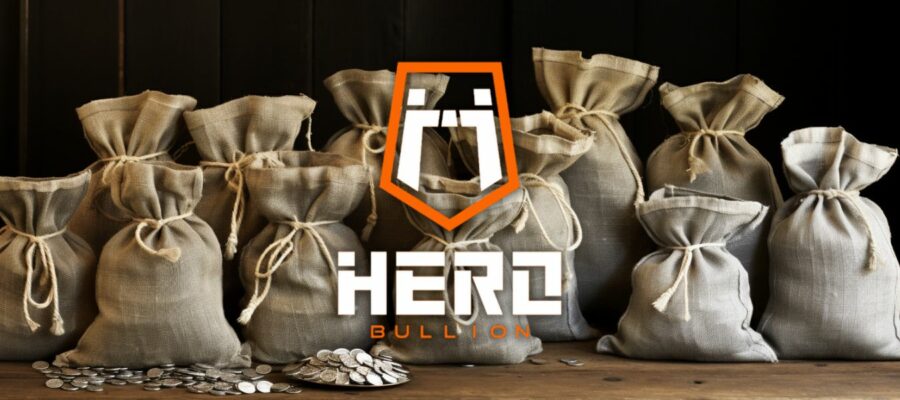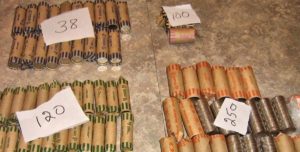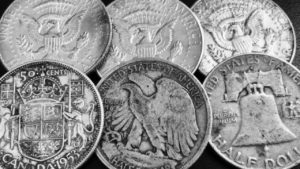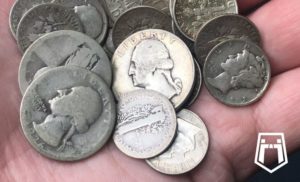How to Find Unsearched Bags of Coins From Banks

Unsearched bags of coins from banks are one of the most popular draws for new bullion and coin collectors. The appeal is very easy to understand. Who wouldn’t want to buy rolls or bags of coins that haven’t been searched? After all, some American coins are worth quite a bit of money. Picking the right coins out of a large pile of unsearched pieces could quickly turn a profit for the coin collector. Particularly old coins, as well as rare coins with mint errors, are some of the most common types of coins to look for in an unsearched bunch of coins. There is also an intrinsic value to finding silver coins. Some coins, especially among older series, might contain coins with high purity silver. These can be worth quite a bit of money! https://www.youtube.com/watch?v=Xio3imJvDVE However, many veteran bullion enthusiasts advise caution for new collectors looking to score with some unsearched bags of coins from banks. There are a few different reasons for this long-held skepticism. To start, coin dealers can easily search their bags, extracting the most valuable coins before marketing them falsely as “unsearched.” It is nearly impossible to distinguish a pre-searched bag from a truly unsealed one, especially when dealing with smaller sellers who have no oversight or accountability. But don’t despair! There are quite a few tips that coin collectors can use to correctly identify, search, and cash-in on the value of unsearched coin bags from banks. Recognizing the key dates for a given type of coin, purchasing from the right distributors, and keeping an eye out for coveted mint error coins are just a few ways that consumers can make the most out of the exciting niche industry of unsearched bags of coins from banks and rolls.
Where to Buy Unsearched Coin Bags
Bullion and coin retailers all over the internet advertise bags of coins from banks they claim to be completely unsearched. The types of coins in these packages will vary. Lincoln cents, buffalo nickels, penny rolls, wheat pennies, and 90% silver coins are just some of the varieties available in these coin bags. United States coin collectors often have their own preferences on which coins to target, and determining these preferences is the first step in searching for sealed bags or rolls of coins.  These bags of coins from banks can be purchased from a number of different types of retailers. Local coin and bullion dealers might offer unsearched rolls. Online distributors are another common way for investors to get a hold of bags of coins from banks that haven’t been picked through. Some mints sell unsearched rolls through their official websites, and other coin distributors sell these same kinds of deals on their eCommerce sites. Another popular way to get rolls or bags of coins from banks that haven’t been searched is to use retail sites like eBay, Amazon, or Craigslist. We are generally cautious of these options. Smaller sellers on these sites usually don’t have any kind of accountability, so there isn’t much to prevent them from removing all of the valuable coins from a pack before resealing them and selling the pack at a premium. The most surefire way to guarantee completely unsearched coins is to purchase them directly from the United States banking system. Some bigger banks will sell large amounts of circulated coins to collectors. The reason this strategy guarantees that the coins won’t be searched is that banks just simply don’t need to look through their coins. Unlike smaller retailers and online sellers, who could increase personal profits substantially by just removing valuable coins and leaving the rest for the buyer, U.S. banks deal in so much circulated coinage that it would be unprofitable to spend time searching through their stock.
These bags of coins from banks can be purchased from a number of different types of retailers. Local coin and bullion dealers might offer unsearched rolls. Online distributors are another common way for investors to get a hold of bags of coins from banks that haven’t been picked through. Some mints sell unsearched rolls through their official websites, and other coin distributors sell these same kinds of deals on their eCommerce sites. Another popular way to get rolls or bags of coins from banks that haven’t been searched is to use retail sites like eBay, Amazon, or Craigslist. We are generally cautious of these options. Smaller sellers on these sites usually don’t have any kind of accountability, so there isn’t much to prevent them from removing all of the valuable coins from a pack before resealing them and selling the pack at a premium. The most surefire way to guarantee completely unsearched coins is to purchase them directly from the United States banking system. Some bigger banks will sell large amounts of circulated coins to collectors. The reason this strategy guarantees that the coins won’t be searched is that banks just simply don’t need to look through their coins. Unlike smaller retailers and online sellers, who could increase personal profits substantially by just removing valuable coins and leaving the rest for the buyer, U.S. banks deal in so much circulated coinage that it would be unprofitable to spend time searching through their stock.
How to Buy Coin Rolls from the Bank
Like we’ve already explained, buying coin rolls from the bank virtually guarantees that they will not be searched. But prying these coin rolls from the clutches of the United States banking system is often harder than it looks! The easiest way to get sealed coin rolls from the bank is to simply ask. Some bank tellers might not know exactly what customers mean when they say they want to buy rolls of circulated coins. This is okay; collectors just need to be firm and informed about what they need from the bank. Bigger banks are almost always going to be better for this purpose. Smaller banks might be able to get the job done. But collectors looking for unique or rarer varieties of coins might have trouble finding what they need from local banks. Some of the largest banks in America are in direct contact with the Federal Reserve, which makes it easier for them to special-order rolls of coins for repeat coin-collecting customers. A lot of people don’t even know that this is an option. But the truth is that almost all banks are capable of selling rolls of coins. There is an additional big advantage to this strategy: the coins just cost face-value. Buying these same untouched rolls of circulated coins from coin dealers often means paying an extra premium on top of the base value of the coins. But when collectors buy directly from the banking system, the cost is just the total face-value price of the coins in the roll.
Buying Unsearched Coins Online
Companies online often offer coin rolls or bags that haven’t been searched or opened. These are almost always big sellers. But there are different types of online sellers. Bigger bullion distributors are one thing, but smaller coin sellers sometimes operate on platforms like eBay and Amazon, as well as Craigslist.  It helps for collectors to first figure out which types of coins interest them. Wheat pennies are some of the most popular coins to be bought and sold in the form of unopened rolls. Wheat pennies are generally not worth very much money; their copper content certainly isn’t worth anything significant. But some key dates are considered exceptionally rare. A few wheat penny editions can carry massive price tags with them. We’ll address some of these dates to look out for later in this guide. Silver dollars are rarely found in rolls, where as junk silver quarters, buffalo nickels, 90% silver dimes, and junk silver Kennedy half dollars are some other major coin models sold in this way. Most Eisenhower silver dollars are clad copper nickel, and have no precious metal value, but there is a 40% silver Ike silver dollar so be sure to look at the edge of the coin to see if it is two toned. As a general rule, nearly any kind of coin can be valuable. American quarters are frequently sold in unopened bags, rolls, and boxes. The big thing to remember when buying unsearched bags and coin rolls from sellers other than US banks is that the trustworthiness of the seller is everything. Truthfully, there is no guaranteed way to make sure that the seller has not opened the roll/bag, picked out the most expensive or rare coins, and then closed it before selling it to a collector. Learning to seal coins just like the federal banking system does is not very difficult, and any seasoned seller will know how to do it. This makes it even harder to know whether or not a selection of coins has been searched. We recommend that consumers try to find a seller with an exceptionally strong reputation for honesty and consistency before choosing to buy this type of coin package.
It helps for collectors to first figure out which types of coins interest them. Wheat pennies are some of the most popular coins to be bought and sold in the form of unopened rolls. Wheat pennies are generally not worth very much money; their copper content certainly isn’t worth anything significant. But some key dates are considered exceptionally rare. A few wheat penny editions can carry massive price tags with them. We’ll address some of these dates to look out for later in this guide. Silver dollars are rarely found in rolls, where as junk silver quarters, buffalo nickels, 90% silver dimes, and junk silver Kennedy half dollars are some other major coin models sold in this way. Most Eisenhower silver dollars are clad copper nickel, and have no precious metal value, but there is a 40% silver Ike silver dollar so be sure to look at the edge of the coin to see if it is two toned. As a general rule, nearly any kind of coin can be valuable. American quarters are frequently sold in unopened bags, rolls, and boxes. The big thing to remember when buying unsearched bags and coin rolls from sellers other than US banks is that the trustworthiness of the seller is everything. Truthfully, there is no guaranteed way to make sure that the seller has not opened the roll/bag, picked out the most expensive or rare coins, and then closed it before selling it to a collector. Learning to seal coins just like the federal banking system does is not very difficult, and any seasoned seller will know how to do it. This makes it even harder to know whether or not a selection of coins has been searched. We recommend that consumers try to find a seller with an exceptionally strong reputation for honesty and consistency before choosing to buy this type of coin package.
How to Identify Valuable Coins
For new collectors, nothing is more exciting than the rush of finding a valuable and rare coin among a selection of common ones. But when collectors are holding onto a large number of coins, time is of the essence. Developing the good sense to quickly identify which coins are rare takes some getting used to. But with a little bit of studying, collectors can learn to pick the right coins out of a roll with ease. When working with coin rolls where the most valuable coins are made of silver or gold, one strategy is to unpackage the pieces, but keep them tightly held together in a roll. The edges of coins will change in appearance based on their precious metal composition. Silver coins, for instance, will stick out like a sore thumb when resting against a sea of low-grade metal coins, often called “silver clad coins.” Identifying coins with rarity derived from minting errors or key dates is a little bit more difficult. Key dates are generally years where a particular coin was minted very rarely in contrast to coins that get their value from their gold and silver precious metal content. This means that the circulation of these coins is lower than in other years, so they’re worth more. The key date isn’t the only thing that matters in the rarity of a coin. The small letter written next to the date is the mint mark, which represents the city where the coin was struck. Some mints only produced very few of a given coin in a given year, making that year and mintmark combination rarer than others. Some collectors and bullion fans also split some coins into the subcategory of ‘semi-key dates.’ These coins are rarer than common coins, but not quite as coveted as key dates. As a general rule, all coins are subject to these basic tests of rarity. Rare coins will almost invariably either be struck with a metal seldom used in the series or minted at a year and location which is rare. We suggest that collectors interested in coin hunting look into one of the many key date lists available for the kinds of coins they want to search for. Over time, casting aside the common dates and keeping only key or semi-key dates will become second nature.
Frequently Asked Questions
New collectors are right to have quite a few questions about finding, buying, and sifting through unsearched bags of coins from banks. Read on to learn the answers to many of the most commonly asked questions on the topic.
Q: Are unsearched bags impossible to find?
A: Some collectors claim that every bag or roll of coins has been searched at some point. While it is true that many bags of coins from banks advertised as unopened have actually been sifted through by the seller, finding an honest and reputable seller makes this unlikely to be the case.
Q: Will banks sell coin rolls to anyone?
A: The best way to ensure that a bank will sell coin rolls is to get an account with them. Most banks are more than willing to do business with anyone who wants to buy their coin rolls, but they may be more flexible and accommodating with paying account holders of the bank.
Q: Are coin rolls worth it?
A: Rolls of coins are sometimes worth the money. The best way to minimize risk buying coin rolls is to purchase them directly from the US banking system. Coins bought in this way cost only their face value.
Q: How are unopened bags of coins from banks found?
A: There are a few ways that retailers get ahold of unopened bags. Some unopened bags are found buried; people buried coins frequently during the Great Depression. Others are found in old vaults, attics, and storage units.
The Bottom Line: Unsearched Coin Bags
Unopened coin bags and rolls of coins are a fantastic and fun way for investors to potentially expand their collection. Some fans of bullion are cautious of the claim that any bag of coins is truly “unsearched.” There is some truth to this fear. Many bullion sales people probably open up their bags of coins from banks and extract the key dates and valuable coins before passing them onto their customers. Still, there are several ways to make the most of what unopened penny rolls and other unsearched coin lots have to offer. Our advice? Either work with banks or with extremely trustworthy dealers. Doing so helps to sure-up the odds that those lots have truly never been searched.  One of the biggest obstacles for new collectors is figuring out what to keep, and what to throw away. Getting around this barrier takes a lot of research and some hands-on work. Using tips like holding coins in roll form to identify which are made from unique precious metals are helpful. But at some point, collectors need to be able to spread the coins out and start to identify the rarer dates and mint symbols on the faces of their pieces. With such a wide variety of valuable coins sold in bags from so many different retailers, it is important for collectors to take the time to orient themselves to the value indicators used for United States coins. After you find the right kind of coin and the perfect distributor, it’s time to get searching!
One of the biggest obstacles for new collectors is figuring out what to keep, and what to throw away. Getting around this barrier takes a lot of research and some hands-on work. Using tips like holding coins in roll form to identify which are made from unique precious metals are helpful. But at some point, collectors need to be able to spread the coins out and start to identify the rarer dates and mint symbols on the faces of their pieces. With such a wide variety of valuable coins sold in bags from so many different retailers, it is important for collectors to take the time to orient themselves to the value indicators used for United States coins. After you find the right kind of coin and the perfect distributor, it’s time to get searching!
About The Author
Jake Haugen
Follow @herobullionHero Bullion provides an environment that is informative and safe for those looking to own physical gold and silver bullion as an investment. We love helping folks at all stages throughout their bullion journey making progress towards acheiving their financial goals. Whether you are a seasoned bullion investor or brand new to the game of gold and silver bullion ownership, we're here to help and serve you in any way we can.
